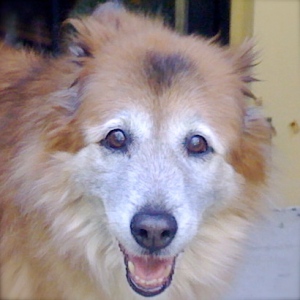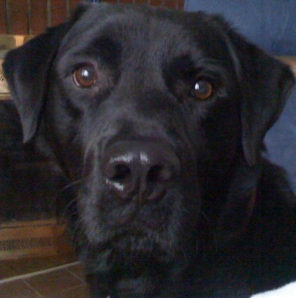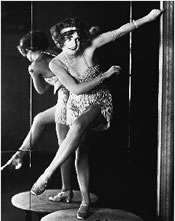I never knew how much I enjoyed the company of dogs until I didn’t have a dog. Over the past month, I’ve said goodbye to two canine companions—one expected passing due to old age and another unanticipated loss initiated by behavioral issues. Neither was easy, and both were quite different grievings.
 Hera was a dog we adopted from the Humane Society as a puppy, back in 1993. My husband and I had been married for just three years when we brought her home with us. We were young and so was she. Her passing is a milestone in our relationship that bookends her adoption. We took her on vacation, worried over her every need and trained her to be a civilized beast. She was the smartest dog I’ve known. Despite being smaller than most of the dogs we had as buddies for her, she out-maneuvered every other dog. She was the canine equivalent of a chess champion. If she wanted a toy, she pretended that she was in love with another fetch-worthy item until the dog who had the toy she wanted couldn’t help but drop it with unwitting greed. Hera thought well into the future, a quality that most dogs lack.
Hera was a dog we adopted from the Humane Society as a puppy, back in 1993. My husband and I had been married for just three years when we brought her home with us. We were young and so was she. Her passing is a milestone in our relationship that bookends her adoption. We took her on vacation, worried over her every need and trained her to be a civilized beast. She was the smartest dog I’ve known. Despite being smaller than most of the dogs we had as buddies for her, she out-maneuvered every other dog. She was the canine equivalent of a chess champion. If she wanted a toy, she pretended that she was in love with another fetch-worthy item until the dog who had the toy she wanted couldn’t help but drop it with unwitting greed. Hera thought well into the future, a quality that most dogs lack.
Her face was unique. She had a black mask like a raccoon’s, and it grayed with age so that by the time she died it was 100 percent silver and quite striking. The last few years of her life, we had to call her name loudly even when standing next to her, and cataracts made her eyes mood-ring cloudy and she was apt to run into things. When she stopped being able to get up reliably on her own—at all—and seemed to be just biding her time, we made an appointment. She really, REALLY hated being carried around and resented us terribly for it. Her time had come. The vet came to the house, and the family gathered around Hera in the back yard on a beautiful day. It was a very peaceful passing, and she is forever resident underneath the big pine tree at the back of the yard.
 Mobley was a big black hundred-pound mess of supposed Black Lab and Newfoundland melange. Since he didn’t like water and couldn’t retrieve to save his life, I am not entirely sure about his rumored lineage. His head was disturbingly large—providing ample breathing room for a sadly undersized brain. No dog welcomed the world of the backyard in quite the same way as Mobley. Every morning, he could not wait to get outside. The phrase, “He could not contain his excitement,” does not begin to describe Mobley’s insane exuberance. I was routinely knocked over by him either in his goings or comings. I still have bruises and scratches to prove it.
Mobley was a big black hundred-pound mess of supposed Black Lab and Newfoundland melange. Since he didn’t like water and couldn’t retrieve to save his life, I am not entirely sure about his rumored lineage. His head was disturbingly large—providing ample breathing room for a sadly undersized brain. No dog welcomed the world of the backyard in quite the same way as Mobley. Every morning, he could not wait to get outside. The phrase, “He could not contain his excitement,” does not begin to describe Mobley’s insane exuberance. I was routinely knocked over by him either in his goings or comings. I still have bruises and scratches to prove it.
Mobley was only six when we had to make the decision. A heart-wrenching decision. We had invited very good friends to come to the house to say their goodbyes to Hera. They brought their dog with them, and I should have told them not to. As he got older, Mobley became more and more aggressive towards other dogs similar in size to him. Instead of telling our friends to take their dog home, I locked Mobley in the house behind two closed doors while we visited with Hera, our friends and their son and dog in the backyard.
Everything was fine until circumstances went awry. Children came in and out of the house. Doors were opened inadvertently, and Mobley got into the backyard. As he burst out the back door, I knew it was going to be bad. And it was. Mobley viciously attacked my friends’ dog and grabbed its throat in his jaws. He would not let go. We did many things over the course of 10 very long minutes to get the dogs apart. My girlfriend was smart enough to think of turning the hose on the dogs, so that finally we were able to separate them.
My friends’ dog was terribly injured. Both my friends and I had been bitten. That night, my friends spent all night in the ER after taking their dog to MedVet. I went to the urgent care. We all got tetanus shots. As for Mobley, he knew something bad had happened. He just didn’t know that he caused the problem.We were grateful that we had the presence of mind to send the kids all into the front yard while the dog fight was in process.
I rewound and replayed the entire series of events over and over in my mind all week long. I should have told my friends not to bring their dog. I should have locked Mobley in an upstairs room. We should have worked harder to socialize him. Why were we such miserable dog-owners? My failure to control my dog surely made me unpardonable, I told myself.
Mistakes were made, but there’s no rewind in real life. Decisions were imminent. We had to really be grown-ups about this. Because after things happened, we realized that we could not in good conscience adopt Mobley out to another family knowing that this could happen again. We knew we couldn’t keep him safe from other dogs. He could vault the fence and was strong enough to pull us over when leashed. We’d had dogs that we were able to find homes for in the past, either dogs we’d owned ourselves or fostered. And we knew that we had worked hard to train him. There was just something weirdly off with him, something that affected him early in life when his social skills were developing, so that once we adopted him at 2-3 years of age there wasn’t much that could be done. Perhaps he had been trained as a fighting dog. Who knew? He had been rescued after living with numerous owners before us. His behavior was getting more erratic. During a walk during his last week of life, he snapped at a person who wanted to pet him. He was not a bad dog, he was just a dog who would never really change. Although incredibly loyal and devoted to humans, he was a loaded gun with other large dogs.
We talked with our friends whose dog got hurt more than once a day for the week afterwards. And we talked with the family that owned Mobley before us. We told them what we were thinking. That despite the fact that Mobley was true and good in most ways, we felt that as his owners the only responsible choice we could make was to put him to sleep. Sadly, everyone agreed. The affirmation was both validating and painful to hear.
Mobley was a dead dog walking. Because there were bites to humans during the dog fight, we had to quarantine him for 10 days in the event of rabies. And so we bided our time. In some ways it would have been easier to put him down right away, saying our goodbyes and taking swift action. Our house was already quieter for having had to say goodbye to Hera that same week. But we knew that our decision to say goodbye to Mobley was the right one. His former owners came over for a visit. We took him for his last few walks. And we loved him for who he was, nothing more and nothing less.
The passing of Mobley was like his life: tumultuous. We took him into the vet. Because of his size, and because he got nervous around shots, we wanted to be able to help things go smoothly. Well, they didn’t. The vet had to give him two doses of a sedative to get him calm enough for the shot of sodium pentathol. He had to be double-muzzled to keep from biting the vet. And then the anesthesia had to be administered three times because he was so full of life. I am sorry to say that he just would not go quietly. The entire event took about an hour from start to finish. We were physically spent from helping to keep him still, and emotionally worn out from the trauma of making the decision and then seeing it through.
The kids were with a neighbor during all of this. On the way home, I talked with the mother and apologized that we were so late, explaining why. She said, “Well, God didn’t mean death to happen that way.” She didn’t mean to be harsh, and I wholeheartedly agreed with her sentiment. And I wouldn’t wish it on anyone else, dog-owner or dog.
It’s been about a month now since everything happened. I hesitated about posting this. Judgment from people about situations like this can be quite cutting. Fair warning: If anyone comments about the decision, giving advice about why we should have chosen differently, I won’t publish the comment and probably won’t read all of it. I just can’t second-guess the choice we made. Making the decision was difficult enough.
I believe that as animal “owners” we become the stewards of our animals. They are like family members. If you’d asked me a year ago whether I would ever consider having to take this course of action, I would have said no. And I would expect most people to not really understand getting to the point of having to make this kind of decision for an animal in their care. It is truly the worst possible decision to make.
We have been healing, but we’re missing our dogs. Hera and Mobley were incredible companions. We know that their souls have moved to the great beyond. With some trepidation, we are taking steps to get a puppy that we can train from the ground up. We’ll see where this goes, but if I had to guess I’d say that we will soon again be in the company of canines.
Tags: dogs, family, friends, life, nature
 My first experience with public speaking was with the Reynoldsburg, Ohio Optimists’ Club. I was in fourth grade (I think?). My memory is not so good here, probably because this was not a positive experience. Sorry, Optimists!
My first experience with public speaking was with the Reynoldsburg, Ohio Optimists’ Club. I was in fourth grade (I think?). My memory is not so good here, probably because this was not a positive experience. Sorry, Optimists!



 Hera was a dog we adopted from the Humane Society as a puppy, back in 1993. My husband and I had been married for just three years when we brought her home with us. We were young and so was she. Her passing is a milestone in our relationship that bookends her adoption. We took her on vacation, worried over her every need and trained her to be a civilized beast. She was the smartest dog I’ve known. Despite being smaller than most of the dogs we had as buddies for her, she out-maneuvered every other dog. She was the canine equivalent of a chess champion. If she wanted a toy, she pretended that she was in love with another fetch-worthy item until the dog who had the toy she wanted couldn’t help but drop it with unwitting greed. Hera thought well into the future, a quality that most dogs lack.
Hera was a dog we adopted from the Humane Society as a puppy, back in 1993. My husband and I had been married for just three years when we brought her home with us. We were young and so was she. Her passing is a milestone in our relationship that bookends her adoption. We took her on vacation, worried over her every need and trained her to be a civilized beast. She was the smartest dog I’ve known. Despite being smaller than most of the dogs we had as buddies for her, she out-maneuvered every other dog. She was the canine equivalent of a chess champion. If she wanted a toy, she pretended that she was in love with another fetch-worthy item until the dog who had the toy she wanted couldn’t help but drop it with unwitting greed. Hera thought well into the future, a quality that most dogs lack. Mobley was a big black hundred-pound mess of supposed Black Lab and Newfoundland melange. Since he didn’t like water and couldn’t retrieve to save his life, I am not entirely sure about his rumored lineage. His head was disturbingly large—providing ample breathing room for a sadly undersized brain. No dog welcomed the world of the backyard in quite the same way as Mobley. Every morning, he could not wait to get outside. The phrase, “He could not contain his excitement,” does not begin to describe Mobley’s insane exuberance. I was routinely knocked over by him either in his goings or comings. I still have bruises and scratches to prove it.
Mobley was a big black hundred-pound mess of supposed Black Lab and Newfoundland melange. Since he didn’t like water and couldn’t retrieve to save his life, I am not entirely sure about his rumored lineage. His head was disturbingly large—providing ample breathing room for a sadly undersized brain. No dog welcomed the world of the backyard in quite the same way as Mobley. Every morning, he could not wait to get outside. The phrase, “He could not contain his excitement,” does not begin to describe Mobley’s insane exuberance. I was routinely knocked over by him either in his goings or comings. I still have bruises and scratches to prove it.